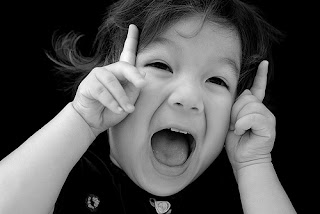(P. Ketron, 2010)
How does a child communicate their wants, needs and desires if they cannot speak or be understood in the same 'language'? Why does it seem that speech is the privileged or dominant method of communication while other ways to communicate are considered marginalized? Mitchell (2009), highlights that “Disabled people with learning and communication impairments are frequently viewed as incompetent and unknowing and this can be a negative effect on their inclusion...” ( p. 15).
Consider this example of a child expressing themselves in a peer group situation, “...A group of children was playing noisily around the table when one of the children, who had no formal communication style, joined in by squealing and spitting. Immediately the staff halted the children's games judging that the behaviour was inappropriate” (Cocks, 2008, p. 164). Not only was this child's participation in the peer group excluded but their voice was silenced as well. How do we as educators listen to each child's 'language' and appreciate their multiple intelligences and ways of communicating? The solution stems from our image of the child as competent and capable.
Children with and without a disability participate in a wide range of non-verbal communication. This includes but is not limited to: signing, facial expressions, tone and pitch of voice, blinking, and moving their fingers in a response to simple yes and no questions. How can these methods of communication and others be equally valued within our classrooms and throughout society?
To be included (Kenworthy & Whittaker, 2000, as cited in Bunning, 2007), implies acceptance of and support for diverse ways of communicating and engaging socially (Bunning 2004 ). So what a person has to say through the use of graphic and gestural communication to support impaired language is attributed the same worth as the person who communicates through linguistic code” (Bunning, 2007, p. 17).In valuing children and their individual ways to communicate we subscribe to a holistic view of expression. A dramatic shift in our current awareness and disruption of our preconceived truths is needed.
References
Bunning, K.; Horton, S. (2007). “Border crossing” as a route to inclusion: A shared cause with people with a learning disability? Aphasiology, 21 (1), 9-22. DOI: 10.1080/02687030600798162
Cocks, A. (2005). The peer groups of children with learning impairments, in D.Goodley and G. VanHove (eds) Another disability studies reader? pp. 73-92. Antwerp: Garant Publishers.
Ketron, P. (2010). Penelope's Loom. Surprise sign language. Retrieved from: http://www.flickr.com/photos/90588965@N00/1551757179
Mitchell, W. (2009). I know how I feel: Listening to young people with life-limiting conditions who have learning and communication impairments. Qualitative Social Work, 9 (2), 185-203. Retrieved from: http://eprints.whiterose.ac.uk/11153/

No comments:
Post a Comment